The different marguerite species and varieties differ not only in their occurrence and their flower shapes.

daisies (Leucanthemumspecies) are popular plants for gardens and balconies. In our Daisies review article learn more about the origin, flowering time and reproduction of the plant. Below is all the information about the most popular types and varieties of daisies for the garden. Among other things, you will learn which types of daisies are hardy and which varieties have the most beautiful flower shapes.
Contents
- Types and Varieties of Marguerites: How Many Are There?
-
The most beautiful marguerite varieties and species at a glance
- Meadow daisy (Leucanthemum vulgare)
- Garden daisy (Leucanthemum maximum)
- Large-flowered garden daisy (Leucanthemum x superbum)
- Leucanthemum x superbum var. Nanus
- Narrow-leaved Marguerite (Leucanthemum graminifolium)
-
Other genera trivially referred to as daisies
- Moroccan daisy (Rhodanthemum hosmariense)
- Marguerite (Argyranthemum frutescens)
- Variegated Marguerite (Tanacetum coccineum)
Types and Varieties of Marguerites: How Many Are There?
There are two native daisy species in Germany – Leucanthemum vulgare and Leucanthemum atratum. The dry meadow daisy (Leucanthemum vulgare) is particularly widespread. There are probably around 42 species of daisies all over the world. Because daisies are such popular ornamental plants that have been cultivated for centuries, there are many man-made varieties. Around 100 varieties are available in stores today.
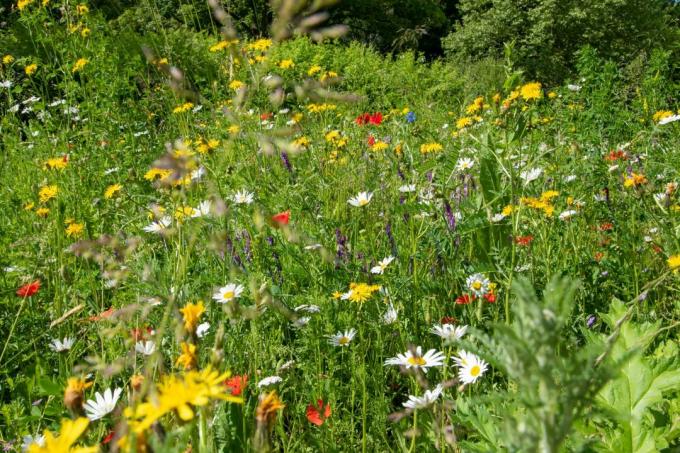
The most beautiful marguerite varieties and species at a glance
The different types of daisies differ not only in the color and shape of the flowers. There are also differences in their height, competitiveness, flowering time and persistence - and therefore in how long we can enjoy them. We present a few species and varieties in detail.
Meadow daisy (Leucanthemum vulgare)
The Wild Marguerite Leucanthemum vulgare is probably the best-known species in the genus der Leucanthemum. It is also known under the name meadow daisy, whereby the species group of meadow daisies also includes the fat daisy (Leucanthemum ircutianum) belongs. The two are very closely related and differ mainly in their preference for location. The flowers of Leucanthemum vulgare consist of white ray florets and central yellow tubular florets. It can be found wild on flower meadows and along the edges of paths, where it forms loose, wide clumps. It is also one of the short-lived perennials, but is hardy and perennial. The meadow daisy goes well in cottage gardens, herbaceous borders and front gardens.
Compared to the original wild species, the varieties need more nutrients in the substrate and are less resistant to dry periods.
- Leucanthemum vulgare 'May Queen': Simple, white flower with a yellow centre, flowering period from May to July, large and vigorous growth, up to 70 cm high.
- Leucanthemum vulgare 'May Miracle': Short, wide, white marguerite flowers with a yellow center from May to July, compact habit, up to 50 cm high.
- Leucanthemum vulgare 'Maister': Pointed, long, white flowers with a yellow centre, flowering period from June to August, compact habit, up to 60 cm high.
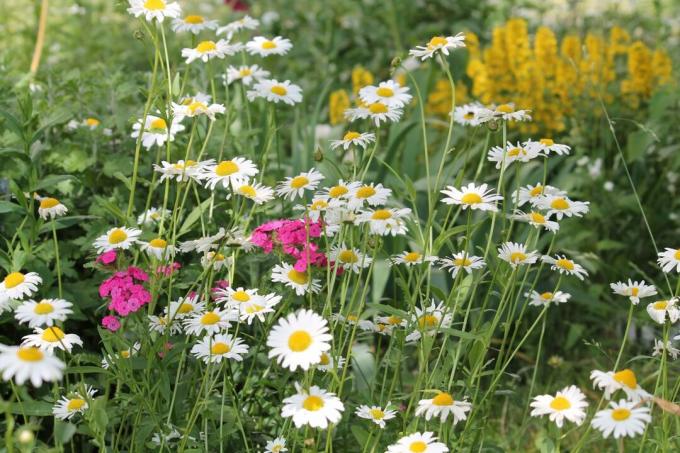
Garden daisy (Leucanthemum maximum)
The garden daisy is a close relative of the meadow daisy, but differs significantly from it. It is also called summer marguerite. A good location for the Leucanthemum maximum is low in nitrogen, moderately dry and very sunny. The substrate should be permeable. It is usually commercially available as a cross with other species. The best-known hybrid is with the species Leucanthemum lacustre, making the hybrid kind Leucanthemum x superbum originated. All marguerite varieties from Leucanthemum maximum can grow both in beds and in pots. In a container, however, it is more difficult to hibernate the garden daisies, despite their relatively good winter hardiness, because the small volume of soil freezes through more quickly or they suffer from waterlogging.
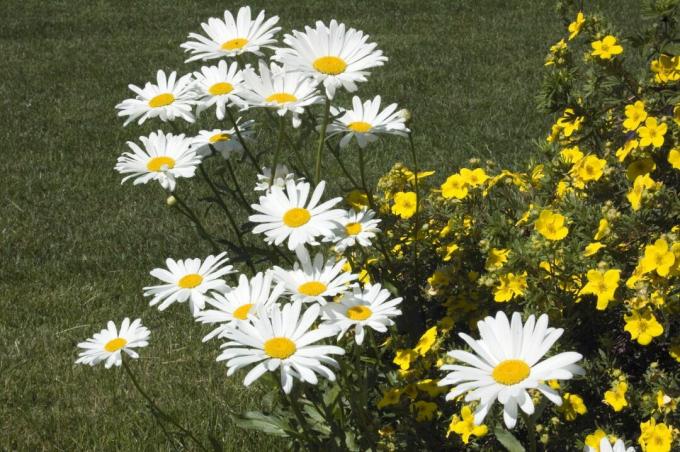
Large-flowered garden daisy (Leucanthemum x superbum)
This hybrid species is a cross between the two species Leucanthemum maximum and Leucanthemum lacustre. Most varieties of the large-flowered garden daisy prefer nutrient-rich, well-drained soil and plenty of sun. They are also hardy, although it is also true here that they cannot with certainty overwinter in pots due to the small volume of soil and a lot of moisture. The flowers of Leucanthemum x superbum are more profuse than those of the parent species, and their flower colors and shapes vary between the different cultivars.
- Leucanthemum x superbum 'group pride': Single, white flower with a yellow centre, only up to 30 cm high.
- Leucanthemum x superbum 'Crazy Daisy': Ruffled, creamy-white daisy flower with yellow center, some flowers double and others semi-double, height up to 70 cm.

- Leucanthemum x superbum 'Engelina': Short, full, ruffled, white flowers with a yellow centre, up to 50 cm high.

- Leucanthemum x superbum 'Alaska': Single, white flower with a yellow centre, up to 80 cm high.
- Leucanthemum x superbum ‘Banana Cream’: Plant up to 50 cm tall with single, creamy yellow flowers with a yellow center.
Leucanthemum x superbum var. Nanus
There is a subspecies of the large-flowered garden daisy Leucanthemum x superbum Nanus. However, it has not yet been conclusively clarified whether this subspecies does not belong to the chrysanthemums heard.
- Leucanthemum x superbum Nanu's 'Dwarf Snow Lady': Large, single, white flower with a yellow centre, only up to 20 cm high.
- Leucanthemum x superbum Nanus 'Silver Princesses': Single and white flowers with a yellow center, height only up to 30 cm.

Tip: The stuffed leucanthemumSpecies are not particularly insect or bee friendly. Accordingly, unfilled variants should be preferred if you also want to welcome insects in the garden.
Narrow-leaved Marguerite (Leucanthemum graminifolium)
This type of genus Leucanthemum comes from France and prefers a sunny to semi-shady location with nutrient-rich, moist soil. As its common name suggests, its leaf shape is narrower than that of the other species. Its flowers are white with a yellow center. This marguerite is winter-hardy down to temperatures of – 19 °C. The perennials grow up to 30 cm high.
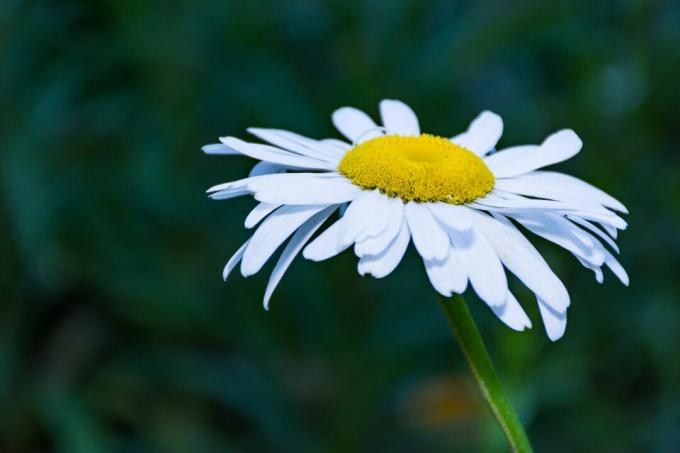
Tip: Once you've decided on a species, it goes to that Planting the Marguerite. We will help you and show you everything you need to consider.
Other genera trivially referred to as daisies
Moroccan daisy (Rhodanthemum hosmariense)
The Rhodanthemum hosmariense is new to the range, which is why there are only few empirical values for durability and winter hardiness. It prefers a sunny, dry and stony location and gets by with few nutrients. There are varieties with different flower colors.
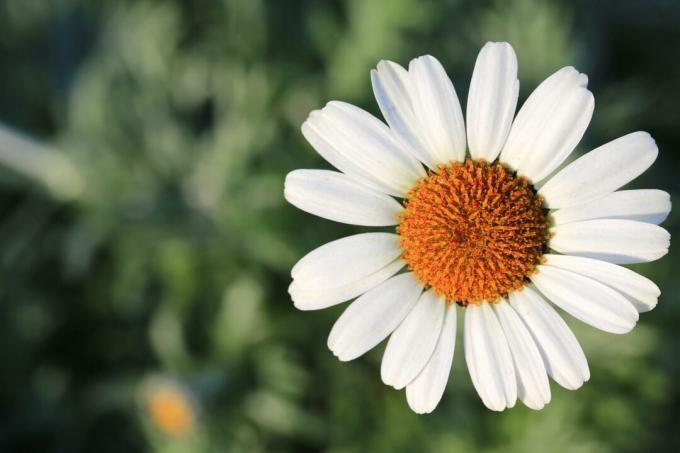
Marguerite (Argyranthemum frutescens)
The African daisy originally comes from the Canary Islands, where it grows wild. The rather unusual species is also known as potted marguerite. It is long-lived but not hardy and prefers well-drained, nutrient-rich soil in a sunny spot. The shrub daisy can also be purchased as a standard, so that it can grow up to 150 cm high. There are also some dwarf varieties that are suitable as ground cover or bed borders and do not grow larger than 30 cm. Their inflorescences can consist of 4 to 30 individual flowers.

Variegated Marguerite (Tanacetum coccineum)
From a taxonomical point of view, the colorful marguerite does not belong to the daisies at all, but to the wildflowers - like the ubiquitous, fragrant tansy (Tanacetum vulgare). The plant, trivially called marguerite, attracts attention with its unusual flower colors. Its flowers bloom in pink or red and grow on stalks that can reach 1 m in height. This plant also prefers a sunny location with nutrient-rich, well-drained soil. In addition, it is one hardy marguerite. Especially in combination with white marguerite species, it creates a beautiful picture in the garden.

If you can't get enough of the beautiful flowers of your marguerite, it helps to regularly remove old inflorescences. This encourages the daisy to produce more flowers. More tips on how to care for daisies, is available in our special article.
Register now for the Garten-Post and receive great tips, seasonal trends and inspiration on everything to do with the garden from our expert every week.
